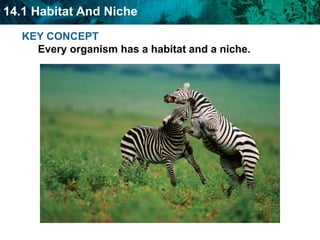Unit 15a Habitat niche interactions and growth patterns
•Download as PPTX, PDF•
6 likes•2,177 views
Report
Share
Report
Share

Recommended
More Related Content
What's hot
What's hot (20)
Viewers also liked
Viewers also liked (20)
Unit 18a DNA fingerprinting and genetic engineering

Unit 18a DNA fingerprinting and genetic engineering
Unit 16a Resource consumption pollution and greenhouse effect

Unit 16a Resource consumption pollution and greenhouse effect
Unit 14a Relationships, biotic, and abiotic factors

Unit 14a Relationships, biotic, and abiotic factors
Similar to Unit 15a Habitat niche interactions and growth patterns
Similar to Unit 15a Habitat niche interactions and growth patterns (20)
BIODIVERSITY KEY TO MORE VARIETY_BIO_X_Learner's Copy.pptx

BIODIVERSITY KEY TO MORE VARIETY_BIO_X_Learner's Copy.pptx
1 3interactionsamonglivingthings-090513100506-phpapp01

1 3interactionsamonglivingthings-090513100506-phpapp01
More from Olympus High School - Jeff Taylor
More from Olympus High School - Jeff Taylor (18)
SDS Episode2 - The Habitat Requirements of Pacific Northwest Bats

SDS Episode2 - The Habitat Requirements of Pacific Northwest Bats
Unit 15a Habitat niche interactions and growth patterns
- 1. KEY CONCEPT Every organism has a habitat and a niche.
- 3. food
- 7. The niche will be divided.
- 9. Competition and predation are two important ways inwhich organisms interact. Competition occurs when two organisms fight for thesame limited resource. Intraspecificcompetition Interspecificcompetition Where else have we used “intra” and “inter” In Biology this year?
- 14. KEY CONCEPT Populations grow in predictable patterns.
- 15. Changes in a population’s size are determined by immigration, births, emigration, and deaths. The size of a population is always changing. Why? Four factors affect the size of a population. immigration births emigration deaths
- 16. Population growth is based on available resources. Exponential growth is a rapid population increase due to an abundance of resources. What would you expect to happen after exponential growth?
- 17. Logistic growth is due to a population facing limited resources. What do you suppose the carrying capacity is?
- 19. competition
- 23. What does the term ecological equivalents describe? A. species that occupy the same niche in the same community B. species that occupy similar niches in different geographical regions C. species that occupy different niches in the same habitat D. species that occupy different niches in different geographical regions Correct Answer = B What is the habitat of a zebra? A. African savannah B. tropical rain forest C. wetland D. mountainside
- 24. What does the term ecological equivalents describe? A. species that occupy the same niche in the same community B. species that occupy similar niches in different geographical regions C. species that occupy different niches in the same habitat D. species that occupy different niches in different geographical regions Correct Answer = B What is the habitat of a zebra? A. African savannah B. tropical rain forest C. wetland D. mountainside Correct Answer = A
- 25. Review A habitat defines the biotic and abiotic factors in an organism’s surroundings A niche includes the habitat and all other factors a species needs to survive, be healthy, and reproduce Competition over resources structures a community. Symbiotic relationships include mutualism, commensalism, and parasitism. Changes in population sizes arise from immigration, births, emigration, and deaths. Population growth is typically limited by resource availability.
